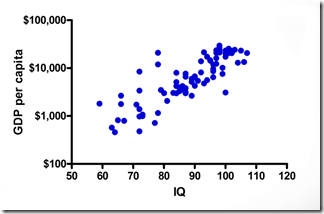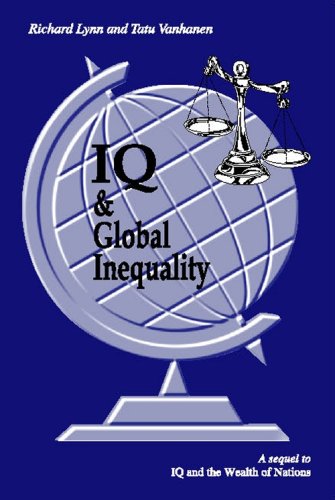Richer Nations have higher intelligence, colder winters & lighter skin color.
GDP (income) of Nations correlates with National IQ
| Correlation between IQ (Intelligence) and GDP of a nation In a reanalysis of the Lynn and Vanhanen’s […] IQ explaining approximately 70% of the variation in GDP.[20] Dickerson concludes that as a rough approximation “an increase of 10 points in mean IQ results in a doubling of the per capita GDP.”  Source: Wikpiedia:IQ_and_the_Wealth_of_Nations Source: Wikpiedia:IQ_and_the_Wealth_of_Nations |
Barber (2005) found that national IQ was associated with rates of secondary education enrollment, illiteracy, and agricultural employment. The effect on illiteracy and agricultural employment remained with national wealth, infant mortality, and geographic continent controlled.
Both Lynn and Rushton have suggested that high IQ is associated with colder climates. To test this hypothesis, Templer and Arikawa (2006) compare the national IQ data from Lynn and Vanhanen with data sets that describe national average skin color and average winter and summer temperatures. They find that the strongest correlations to national IQ were −0.92 for skin color and −0.76 for average high winter temperature. They interpret this finding as strong support for IQ-climate association. Other studies using different data sets find no correlation |
Race and Intelligence research by Richard Lynn shows a vast support for theses similar to Rushton’s, that led to my writing this prior blog article Race differences in intelligence: how research changed my mind to overcome the “all races are equal” dogma. and other blog articles in the category racial-differences-intelligence. Richard Lynn extends conclusions from the individual sphere to National Wealth.
Human Stupidity Analysis
Lynn might not be the last word or the total truth. His ideas are extremely important and very relevant. But his research is so extremely politically incorrect, that others don’t dare to follow his line, to really analyze his research, to prove or disprove it. The race and intelligence relation is clearly established but is taboo.
Discussion about racial discrimination and quotas would be very different if racial differences were taken into consideration. Richard Lynn correlating the fate of entire nations and continents to IQ, that is even more astounding.
In US, average IQ for African Americans (85), Hispanic (89), White (103), East Asian (106), and Jewish Americans (113).
| As the title implies, Richard Lynn’s new book builds on Herrnstein and Murray’s (1994) The Bell Curve. The theme of the book is an examination of whether the same type of racial hierarchy in IQ and socio-economic status that Herrnstein and Murray documented in the US is present in other parts of the world. Herrnstein and Murray found that the average IQ for African Americans (85) is lower than for Hispanic (89), White (103), East Asian (106), and Jewish Americans (113). Lynn shows in detail that similar racial IQ/socio-economic hierarchies are present within Africa, Australia, Brazil, Britain, Canada, the Caribbean, Latin America, the Netherlands, and New Zealand.
Throughout the world, Europeans and East Asians (Chinese, Japanese and Koreans) average the highest IQs and socio-economic positions, while the lowest averages are found among the Aborigines in Australia and in Africans and their descendants. Intermediate positions are occupied by the Amerindians, the South Asians from the Indian subcontinent, the Maori in New Zealand, and the mixed race peoples in South Africa, Latin America, and the Caribbean. The same pattern is found on multifarious social and life history indicators such as educational levels, earnings, health, accidents, crime, marriage, fertility, and mortality. Book review by J.P.Rushton: Personality and Individual Differences 45 (2008) 113-114 |
 The Global Bell Curve: Race, IQ, and Inequality Worldwide by Richard Lynn $49.95 1593680309 |
Intelligence as one factor in accounting for disparities between rich and poor countries
 IQ and the Wealth of Nations by Richard Lynn $102.95 027597510X IQ and the Wealth of Nations by Richard Lynn $102.95 027597510X
Review“Lynn and Vanhanen have made a major contribution to highlighting the importance of intellegence as one factor in accounting for disparities between rich and poor countries.”–Development Policy Review “Lynn and Vanhanen have launched a powerful challenge to economic historians and development economists …”–Heredity Product DescriptionLynn and Vanhanen argue that a significant part of the gap between rich and poor countries is due to differences in national intelligence (national IQs). Based on an extensive survey of national IQ tests, the results of their study challenge the previous theories of economic development and provide a new basis to evaluate the prospects of economic development throughout the world. Source: Amazon.com IQ and the Wealth of Nations by Richard Lynn $102.95 027597510X |
Race differences in IQ
Most of my work has been on intelligence. My major discoveries are that the Oriental peoples of East Asia have higher average intelligence by about 5 IQs points than Europeans and peoples of European origin in the United States and elsewhere; and that men have a higher average IQ than women by about 5 IQs points. I first published the high IQ of the Oriental peoples in 1977 in a paper on the intelligence of the Japanese. In subsequent years the high Oriental IQ has been confirmed in numerous studies of Oriental peoples in Hong Kong, Taiwan, South Korea, China, Singapore and the United States. Richard Lynn, Professor Emeritus, University of Ulster
Free download of Richard Lynn’s Articles
For instant gratification get some articles via free download:
- Intelligence and the Wealth and Poverty of Nations (RICHARD LYNN) Download PDF Wikpiedia:IQ_and_the_Wealth_of_Nations
- Richard Lynn and Tatu Vanhanen IQ and Global Inequality. (2006). Download PDF
- RACE, EVOLUTION, and BEHAVIOR: A Life History Perspective, by J.P. Rushton (various languages) Abridged Edition in English
PFS 2010 – Richard Lynn, On Human Diversity: The Global Bell Curve. Updates and Critical Replies from Sean Gabb on Vimeo.
PFS 2010 – Hans-Hermann Hoppe, Richard Spencer, Marco Bassani, Paul Gottfried, Richard Lynn, Discussion, Q & A from Sean Gabb on Vimeo.
National IQs explain much of the variation between nations in a wide range of economic and social phenomena
 IQ and Global Inequality by Richard Lynn and Tatu Vanhanen $17.95 1593680244 IQ and Global Inequality by Richard Lynn and Tatu Vanhanen $17.95 1593680244
Product DescriptionWe address the following questions. First, in Chapter 1, we review the major theories of economic growth that have been developed since this problem was considered by Charles de Montesquieu and Adam Smith in the eighteenth century and introduce the 192 countries of this study. In Chapter 2 we define and describe what is meant by intelligence. In Chapter 3, we summarize work showing that intelligence is a determinant of incomes and related phenomena (educational attainment and socio-economic status) among individuals in a number of countries; this is the basis of our theory that the intelligence of national populations is likely to be a determinant of per capita incomes among nations. Chapter 4 describes how we have collected and quantified the IQs of nations and presents new IQ data for a further 32 nations. This brings the total number of nations for which we have measured IQs to 113. In addition, national IQs are estimated for 79 other countries so that we have IQs for all countries with populations of more than 40,000. In Chapter 5, five measures of the quality of human conditions and their composite index (QHC) are introduced as well as 12 alternative variables that measure human conditions from different perspectives. In Chapter 6, the hypothesis on the positive relationship between national IQ and the quality of human conditions is tested by empirical evidence on PPP GNI (Gross National Income at Purchasing Power Parity) per capita in 2002, adult literacy rate in 2002, tertiary enrollment ratio, life expectancy at birth in 2002, and the level of democratization in 2002. Chapter 7 focuses on the relationship between national IQ and the composite index of the quality of human conditions (QHC) The results are analysed at the level of single countries on the basis of regression analyses. The results are checked by exploring the impact of latitude and annual mean temperature on human conditions through national IQ. Chapter 8 shows that national IQ is correlated also with many other variables that measure differences in human conditions from different perspectives. Twelve alternative variables are used in these analyses. Chapter 9 discusses the contributions of genetic and environmental determinants to national differences in intelligence and concludes that the racial identity of the population is the major factor. Chapter 10 considers the causal interactions between our most important measures. Chapter 11 (Criticisms and Rejoinders) discusses and responds to the criticisms made of our theory by reviewers. Finally, we summarize the results and conclusions of this study in Chapter 12 and discuss policy implications. Five appendices complement the text. In Appendix 1, the calculation of national IQs for 113 countries is presented and documented. Appendix 2 includes documented empirical data on the adult literacy rate in 2002, the gross enrollment ratio at the tertiary level of education, PPP GNI per capita in US dollars in 1002, and the life expectancy at birth in 2002 for the total group of 192 countries. Appendix 3 provides documented data on the measures of democracy, of the calculated values of the Index of the Quality of Human Conditions (QHC), and of latitude and annual mean temperature. Appendix 4 includes residuals of regression analyses of the five components of QHC on national IQ for single countries in the group of 192 countries. Appendix 5 provides estimated data on per capita GDP derived from Maddison (2003) for 1500 and 2000 in a group of 109 countries.” |
ReviewThis new book by Richard Lynn and Tatu Vanhanen is an elaboration and extension of their IQ and the Wealth of Nations (2002) in which they showed that IQ scores correlated around 0.70 with per capita income and rates of economic development in over 81 countries. This was a very bold claim. The cause of national differences in wealth is one of the major problems in economics. Hundreds of books have been written on the subject and several journals are devoted to it. Only very rarely is it ever suggested that national differences in intelligence help determine why some nations are so rich while others are so poor. In my view, Lynn and Vanhanen have made what is arguably the most important contribution to economic understanding since Adam Smith showed that free markets promote economic development. They have shown also that national IQs explain much of the variation between nations in a wide range of economic and social phenomena–not just income levels. Their book extends the explanatory power of the concept of intelligence in a way that makes a major contribution to the integration of psychology with the other social sciences. In advancing their intelligence theory, Lynn and Vanhanen begin by noting that economists usually regard it as axiomatic that all peoples of the world have the same intelligence. The assumption that the average level of intelligence is the same in all nations is seriously wrong. Lynn and Vanhanen have examined the matter. They found huge national differences in intelligence. Some countries in sub-Saharan Africa appear to have average IQs of 67. Some of the “Asian Tiger” nations of the Pacific Rim average out at 105. For perspective, the reader might note that an IQ of 70 is the lower limit for primary school educability, and an IQ of 105 the lower limit for College-level (although of course these can always be “dumbed down.” In IQ & Global Inequality, Lynn and Vanhanen have increased the number of countries for which they have calculated measured IQs from 81 to 113. They show that in the new larger sample of 113 countries the correlation between IQ and per capita income for 2002 is 0.68, virtually identical to the correlation reported in their earlier book. A path model in which genes and environment both contribute equally (0.50) to national IQs allows a determination of economic growth (0.71) from 1500 to 2000. These national differences in the rate of economic growth are almost entirely responsible for the contemporary differences in per capita income (0.98). The model also posits that national IQs are determinants of a number of social phenomena such as adult literacy (0.64), enrolment in tertiary education (0.75), life expectancy (0.77), and democratisation (0.57). Some of these phenomena have positive feedback relationships. For instance, nations whose populations have high IQs have high per capita incomes, which enable them to provide high quality nutrition, education, and health care for their children, and these enhance their children’s intelligence. This is the principle of genotype-environment correlation applied to national populations. IQ & Global Inequality addresses more fundamentally the question of the causes of national differences in intelligence. It concludes that these depend on the racial composition of the populations. Thus, the 6 East Asian nations (China, Japan, South Korea, Taiwan, Hong Kong and Singapore) all have IQs in the range of 105 to 108. The 29 European nations all have IQs in the range of 92 to 102, while the 19 nations of sub-Saharan Africa all have IQs in the range of 59 to 73. Thus there is remarkable consistency in the IQs of nations when these are classified into racial clusters. Like many important discoveries in science, it seems obvious in retrospect that these national differences in intelligence must inevitably –J. Philippe Rushton Book review and product description found at: IQ and Global Inequality by Richard Lynn and Tatu Vanhanen $17.95 1593680244 Read more: rlynn.co.uk/index.php?page=richard-lynn-and-tatu-vanhanen-iq-and-global-inequality-2006 |
More book recommendations
 Bell Curve: Intelligence and Class Structure in American Life (A Free Press Paperbacks Book) by Richard J. Herrnstein, Charles Murray $18.99 0684824299 Bell Curve: Intelligence and Class Structure in American Life (A Free Press Paperbacks Book) by Richard J. Herrnstein, Charles Murray $18.99 0684824299
A famous, historically important book. So important, that US President Bill Clinton condemned the book without having read it. I suggest you first buy the more recent books by RIchard Lynn |
Don’t miss the blog articles in category racial-differences-intelligence and the post Race differences in intelligence: how research changed my mind to overcome the “all races are equal” dogma.
 Race, Evolution, and Behavior : A Life History Perspective (2nd Special Abridged Edition) by J. Philippe Rushton $5.95 0965683621
Race, Evolution, and Behavior : A Life History Perspective (2nd Special Abridged Edition) by J. Philippe Rushton $5.95 0965683621 Why Race Matters by Michael Levin $24.95 0965638359
Why Race Matters by Michael Levin $24.95 0965638359